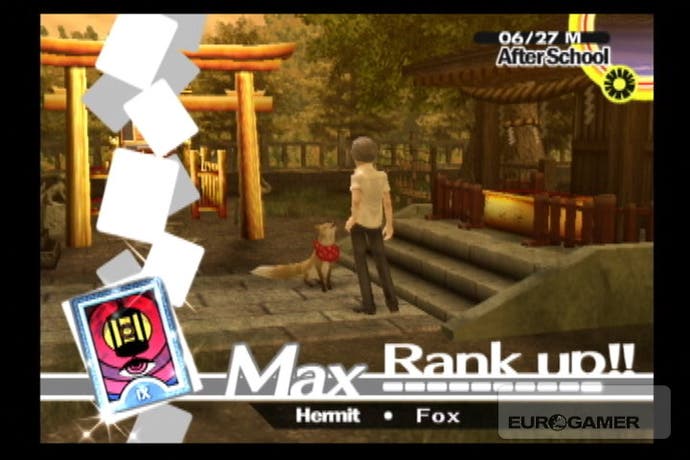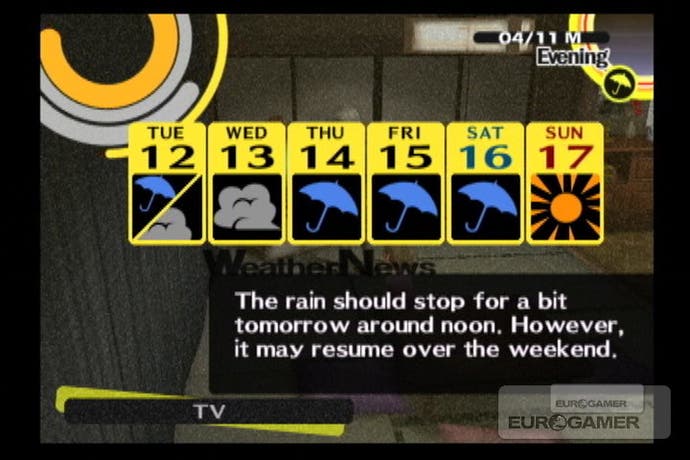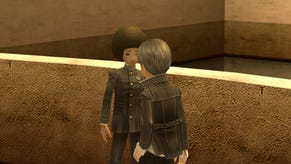Shin Megami Tensei: Persona 4
Old school.
It's a deft blend of writers like Koji Suzuki and, to a lesser extent, Haruki Murakami, and thoroughly exploits the tried-and-tested unsettling powers of misty lanes and flickering television sets, as it slowly pays out the length of its year-long narrative with a lazy elegance. In Japanese literature, horror is something intrinsically tied to the domestic experience, erupting in living rooms and office parks rather than haunted houses and spooky woods, and Persona's clash of genres is built upon exploiting the chill of the familiar as much as a surprising juxtaposition of the uncanny.
The characters help. Cast as a mild-mannered dandy, a fiercely tidy and almost effeminate new kid in a bustling school, you're quickly introduced to a range of Scooby Doo allies, including Kung-Fu obsessed Peppermint Patty-alike Chie, wry but sensitive Yosuke, and refined and aloof Yukiko. Nuanced personality traits and scripting allow the largish cast to rise above the limited animations of their 3D models, while the anime cut-scenes and character art are enough to create a sense of stylised elegance the game itself can't hope to deliver in-engine.
The RPG elements are admirably refined. Exploring the randomly-generated dungeons and battling the wandering Shadows (all of whom are visible prior to attacking, allowing you to choose to avoid them or attempt a pre-emptive strike) is a pacey process, and while there's not much mechanical variation from one location to another, with exploration limited to uncovering the odd treasure chest and hunting for the staircase to the next floor, the visual designs differ significantly, the entirely unexpected tilt of the fourth dungeon in particular likely to become something of a series classic.

Combat is turn-based but brisk, the Kill Bill-flavoured menus offering succinct options against a range of bizarre monsters - examples in the first dungeon alone including pairs of skewered zombies and Rolling Stones tongues that lick you to death. But if the system's slick, it's also deep, with each enemy hiding a weakness to a certain kind of attack which, if uncovered, allows you to down them for an additional battering, or team-up Disgaea-style, wading in en masse, creating a luminous cartoon rumble of dust clouds and jagged onomatopoeias.
Better weapons can be bought at a store in the village, but your main attack options lie with the Personas, mystical psychobabble alter-egos which provide a flashy range of defensive and offensive magical options. Each of your team-mates is tied to a single Persona throughout the game, while you alone have the ability to tactically swap between any that you've found, as well as levelling and fusing up to five at a time to create new varieties in the game's mysterious - and slightly seedy-sounding - Velvet Room.

Unlike Persona 3, direct control of your team is now available alongside the familiar ability to give them basic battle strategies to follow. A fairly major improvement in the context of the game's gentle upgrades from Persona 3, it's not actually as big a deal as you initially imagine: assuming control of your entire group is handy, but if you leave team-mates to work for themselves, you'll find that the game's AI has been significantly improved when it comes to taking care of itself in dust-ups.
Each of the game's dungeons can be completed over a number of different evenings, but you have to save each victim before the end of a string of rainy days in the real world, which will cause the killer to strike again (weather replaces the lunar cycle as Persona 4's primary pace-setter). But this is just one facet of the strict calendar the designers impose. The other lies in between the dungeon exploration, with the series' second defining characteristic: social interaction, based around your life as a Japanese school kid, where your days are divided, like a monk's, into familiar ritualised chunks.





